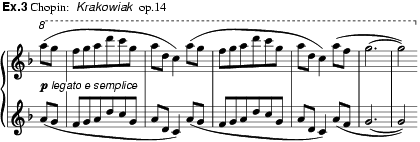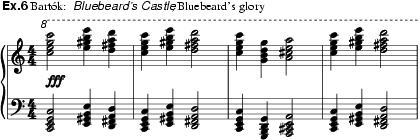
A term applied to a scale, or, by implication, a musical style or system characterized by the use of five pitches or pitch-classes. The term is used more strictly to describe the so-called Anhemitonic pentatonic collection, typified by the set C–D–E–G–A; of the five modes arising from the collection, the major (i.e. with tonic C) is generally regarded as ‘the (common) pentatonic scale’, although the Aeolian mode is also important. The strict sense of the term is justified, given the rarity of hemitonic pentatonic scales (e.g. the Japanese in or the Korean kyemyŏnjo) and the aptness of the term ‘pentachord’ to describe conjunct diatonic collections (for instance, Beethoven's ‘Ode to Joy’ theme). It was in this sense, moreover, that Carl Engel coined the term in 1864, and as far back as Burney writers referred to ‘gapped’ or ‘incomplete’ scales of this sort. (Scrupulous musicologists have rightly cautioned against these adjectives, but the scales do indeed afford the cultivated Western ear interpretative ambiguities between pentatonic and heptatonic hearings). One may further refine the notion of the pentatonic by recognizing the distinctiveness of the scale's minor third ‘steps’; hence the motif G–A–C is more characteristically pentatonic than C–D–E, even though both belong to the same pentatonic scale.
Once described variously as the ‘Chinese scale’ or the ‘Scotch scale’, the pentatonic scale has impressed commentators since at least the mid-19th century for its astonishing ubiquity. A significant feature of such diverse musical traditions as those of the British Isles, West Africa and Amerindian America (among countless others), pentatonicism may well be a musical universal (Chailley, pp.111–28; Nettl, p.42), and many have taken for granted its historical primitivism (Helmholtz, p.257; Suchoff, 1976, p.371; Trĺn). The ethnocentric problems involved in generalizing about scales, however, remind us that defending such grand claims would require the most careful methodology, as pentatonic usage varies widely. For instance, the Chinese system – for which the very propriety of the term ‘pentatonic’ has been questioned (Shen, p.3) – is based on a universe of 12 perfect 5ths, featuring a pentatonic ‘core’ plus two ‘exchange tones’ (bianyin), embellishments that in both theory and practice fill in the minor 3rds (see ex.1a); whereas the Japanese gagaku tradition, while ostensibly founded on this same system, differs in its use of the exchange tones, which assume the nature of Metabole rather than passing notes (ex.1b). The sléndro tuning of Javanese gamelans is pentatonic, though in this case the intervals are more nearly equidistant. Still, such modal and tuning issues notwithstanding, the universalist hypothesis seems compelling, and although the question of primordial scales is far from resolved, a general consensus does exist concerning at least the importance of the pentatonic in the history of music. Whether explained in terms of mono- or polygenesis, this ‘king’ of scales (Trĺn) warrants further research.

The
rise of diatonic tonality seems to have temporarily extinguished pentatonicism
from music (other than folk and traditional musics) in the West. The Romantics,
however, in their quest for originality, undertook notable (if isolated)
experiments using pentatonic materials in the 19th century. These innovations
can be understood ideologically in two ways: as part of a rejection of the
conventional musical language, with a new emphasis on sonorous colour; and as
an embodiment of the Romantic fascination with the ‘Oriental’ (exoticism), with
folk art (primitivism, nationalism) and with medieval Christianity archaism
(see exx.2,
3 and 4
respectively). Carl Maria von Weber, apparently the first of the 19th-century
pentatonicists, used an ‘Air chinois’, copied note for note from Rousseau's Dictionnaire
de musique, as the theme for his incidental music to Schiller's Turandot
(see ex.2).
Chopin's famous Etude in G![]() owes something of its peculiar pentatonic sound to a
technical issue – the right hand playing on black keys – but the earlier Krakowiak,
op.14 (see ex.3), confirms his familiarity
with the scale. Liszt employed pentatonicism to a striking degree, especially
in his solo piano and sacred music (see ex.4). Other composers who used the pentatonic scale include
Mendelssohn, Berlioz, Wagner, ‘the Five’, Mahler, Dvořák, Puccini, and
above all the Impressionists. Though modest in comparison with later practice,
19th-century pentatonicism represents both a subtle change in melodic sensibility
away from common-practice diatonicism and also a reaction against what must
have seemed the cloying tendencies of chromaticism.
owes something of its peculiar pentatonic sound to a
technical issue – the right hand playing on black keys – but the earlier Krakowiak,
op.14 (see ex.3), confirms his familiarity
with the scale. Liszt employed pentatonicism to a striking degree, especially
in his solo piano and sacred music (see ex.4). Other composers who used the pentatonic scale include
Mendelssohn, Berlioz, Wagner, ‘the Five’, Mahler, Dvořák, Puccini, and
above all the Impressionists. Though modest in comparison with later practice,
19th-century pentatonicism represents both a subtle change in melodic sensibility
away from common-practice diatonicism and also a reaction against what must
have seemed the cloying tendencies of chromaticism.



In the 20th century, thanks in large part to Debussy and Bartók (exx.5, 6), the pentatonic scale earned its place among the materials of Western art-music and, consequently, became somewhat less ‘marked’ despite its enduring association with various folk and traditional musics. For Debussy and Ravel, the scale's inherent tonal ambiguities were surely as attractive as its exotic implications. Debussy's direct acquaintance with the pentatonic – through exposure to the gamelan at the 1889 Paris Exhibition – represents a significant change from Weber's armchair anthropology earlier in the century. A further step was taken by Bartók and Kodály, who, in search of their Hungarian musical roots, amassed thousands of vernacular melodies, a portion of which were pentatonic. As composer, Bartók spoke of ‘the tyrannical rule of the major and minor keys’ and described his own pentatonicism as ‘the most suitable antidote for the hyperchromatism of Wagner and his followers’. This decidedly un-Schoenbergian ‘antidote’ proved useful to other composers as well, including Stravinsky (ex.7), Hindemith and Vaughan Williams. The partitioning of the chromatic aggregate into ‘white-’ and ‘black-note’ sets accounts for some less overt pentatonic usage, for instance, in Villa Lobos and Ligeti.



Certain genres of American popular music exhibit pentatonic elements, especially those genres most directly related to African American traditions: from the spiritual (ex.8) to jazz, Motown and rock.

Theorists,
generating the pentatonic scale from a cycle of perfect 5ths, have observed a
host of scalar properties that may be acoustically or psychologically
desirable. For instance, the set enjoys unique multiplicity of interval classes
(<032140>) and so-called ‘optimum consonance’ (Huron). It is both
‘well-formed’ (Carey) and ‘coherent’ (Agmon), and exhibits the ‘f to f![]() property’ (Zweifel), all
assurances of scalar and modulatory integrity. The extent to which these
features account for the apparent universality of pentatonicism, however,
remains speculative.
property’ (Zweifel), all
assurances of scalar and modulatory integrity. The extent to which these
features account for the apparent universality of pentatonicism, however,
remains speculative.
H. von Helmholtz: Die Lehre von den Tonempfindungen als physiologische Grundlage für die Theorie der Musik (Brunswick, 1863, 5/1896; Eng. trans., 1875, 2/1885/R)
C. Engel: The Music of the Most Ancient Nations (London, 1864/R)
Z. Kodály: ‘Otfokú hangsor a magyar népzenében’ [Pentatonicism in Hungarian folk music], Zenei szemle, i (1917); Eng. trans.,EthM, xiv (1970), 228–42
B. Szabolcsi: A melódia törtenete: vázlatok a zenei stilus múltijából(Budapest, 1950, 2/1957; Eng. trans., 1965, as A History of Melody, Ger. trans., 1959, as Bausteine zu einer Geschichte der Melodie)
J. Chailley: Formation et transformation du langage musical (Paris, 1955)
C. Brăiloiu: ‘Pentatony in Debussy's Music’, Studia memoriae Belae Bartók sacra, ed. B. Rajeczky and L. Vargyas (Budapest, 1956, 3/1959)
C. Brăiloiu: Problčmes d'ethnomusicologie, ed. G. Rouget (Geneva, 1973; Eng. trans., 1984)
A. Labussičre: ‘Rhythme enfantin, pentatonismes et giusto syllabique dans les créations mélodiques des enfants’, RdM, lxii (1976), 25–85
B. Suchoff, ed.: Béla Bartók Essays (London, 1976)
H. Avenary: ‘ The Northern and Southern Idioms of Early European Music: a New Approach to an Old Problem’, AcM, xlix (1977), 27–49
D. Beveridge: ‘ Sophisticated Primitivism: the Significance of Pentatonicism in Dvořák's American Quartet’, CMc, no.24 (1977), 25–36
V.K. Trĺn: ‘Is the Pentatonic Universal? A Few Reflections on Pentatonicism’,World of Music, xix/1–2 (1977), 76–84
S. Gut: ‘Liszt et Debussy: comparaison stylistique’, Liszt-Studien II: Eisenstadt 1978, 63–77
M. Kolinski: ‘ The Structure of Music: Diversification Versus Constraint’, EthM, xxii (1978), 229–44
R. Gauldin: ‘ The Cycle-7 Complex: Relations of Diatonic Set Theory to the Evolution of Ancient Tonal Systems’, Music Theory Spectrum, v (1983), 39–55
B. Nettl: The Study of Ethnomusicology: Twenty-Nine Issues and Concepts (Urbana, IL, 1983)
J. Oliveira: ‘ Black Key versus White Key: a Villa-Lobos Device’, LAMR, v (1984), 33–47
J.R. Wheaton: The Diatonic Potential of the Strange Sets: Theoretical Tenets and Structural Meaning in Gustav Mahler's ‘Der Abschied’ (diss., Yale U.,1988)
N. Carey and D.Clampitt: ‘Aspects of Well-Formed Scales’,Music Theory Spectrum, xi (1989), 187–206
S.-Y. Shen: Chinese Music and Orchestration (Chicago, 1991)
G. Hajdu: ‘Low Energy and Equal Spacing: the Multifactorial Evolution of Tuning Systems’,Interface [Amsterdam], xxii (1993), 319–33
D. Huron: ‘Interval-Class Content in Equally Tempered Pitch-Class Sets: Common Scales Exhibit Optimal Tonal Consonance’, Music Perception, xi (1994), 289–305
E. Agmon: ‘Coherent Tone-Systems: a Study in the Theory of Diatonicism’, JMT, xl (1996), 39–59
M. Beckerman: ‘Dvořák's Pentatonic Landscape: the Suite in A Major’,Rethinking Dvořák: Views from Five Countries, ed. D. Beveridge (Oxford, 1996), 245–54
P. Zweifel: ‘ Generalized Diatonic and Pentatonic Scales: a Group-Theoretic Approach’,PNM, xxxiv/1 (1996), 140–61
J. Day-O'Connell: Pentatonicism in Nineteenth-Century Music (diss., Cornell U., in preparation)
JEREMY DAY-O'CONNELL